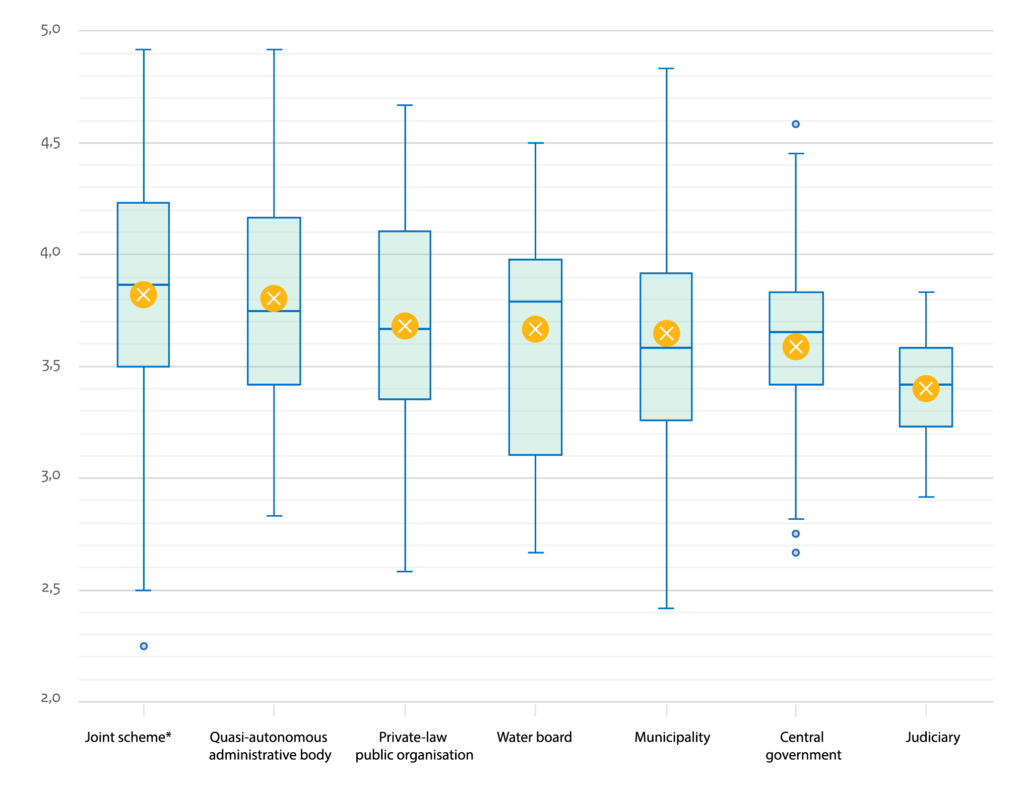Understanding Innovation: The Dutch Innovation Barometer

This guest blog was written by Siwert de Groot, Sil Vrielink (Researchers at the ICTU Foundation, The Hague /NL) and Frans van Dongen (Programme Manager at the Ministry of the Interior and Kingdom Relations, The Hague/NL).
Drawing on the work of the Observatory of Public Sector Innovation and following the lead of the Nordic countries, Denmark in particular, the Dutch Ministry of the Interior and Kingdom Relations has recently published the results of the first Dutch Government Innovation Barometer (2021). In this blog we will present some key insights from the project.
What is the Innovation Barometer?
The Innovation Barometer helps governments understand:
- Where and how innovation is occurring
- The value and impact of innovation
- The importance of organizational culture for innovation
- How organisations and individuals can be better supported in their innovation journeys
The main questions in the Innovation Barometer are these: which innovations were implemented, how did they come about, and what effect did they achieve (what public values did they generate)? We distinguished five public values: quality, efficiency, employee satisfaction, citizen influence, achieving political objectives. In the Dutch context, we invited nearly 1400 government organisations to fill out an online survey comprising of more than 100 questions and sub questions – the response rate was nearly 27% – a satisfactory response rate given the project set-up.
Learning from the Innovation Barometer
In 2019 and 2020, 86% of the Dutch government organisations that took part in the survey implemented one or more innovations. The report itself contains a great deal of information about the nature of the innovations and the way they come about. In this blog we want to focus on a few highlights of the research project.
An English version of the report is available here.
The innovation capacity varies widely between organisations
Analyses of the data showed us that the innovation capacity of Dutch government organisations varies widely, even between organisations that are similar in terms of tasks and size. Based on fifteen underlying indicators, we have developed a single index to measure the organisational culture regarding innovation. Underlying indicators include cooperation within the organisation and with other organisations, the reception of new ideas and innovations from outside of the organisation, how to manage risks and how to cope with failure etc.
In comparison to organisations with an average or a limited innovation climate, government organisations with a powerful innovation climate, more often implement innovations, implement a broader spectrum of innovations and are more successful in terms of the public values they achieve.
Innovation is all about the people and the culture within the organisation.

Figure: score on the Innovation Climate Index, by sector (2019, 2020), n=366.
The above figures shows a boxplot of the organisation scores for the innovation climate (the score can vary from 1 to 5). On average, the scores don’t vary that much between sectors: the sectoral average is depicted by the yellow circle. However, within sectors, organisations – despite being easily comparable in terms of tasks, regulations governing them and the way they are funded – widely differ in their score on the Innovation Climate Index. Based on these results, we conclude that in the Netherlands, successful innovation within government is less dependent on circumstances external to the organisation. The conditions for innovation are largely determined within the organisation itself.
The key factors: employees, safety, and learning
Employees are the crucial factor for successful innovation. The initiative for innovations often originates from employees: they have the necessary knowledge or acquire it through their networks. The survey respondents also state that a wide range of knowledge and skills within teams is essential.
The main difference between organisations with a powerful innovation climate and organisations with a limited innovation climate is the way they deal with failure. Innovation programmes are bound to involve some measure of failure: there must be room for mistakes and opportunities to learn from them. The results from another survey commissioned by the Dutch Ministry for the Interior and Kingdom Relations revealed that, generally speaking, organisational performance is determined to a large extent by the work climate that puts psychological safety and continuous learning and improving first.
If there is no room for failure, you will never achieve innovation.
Conditional factors: collaboration, external orientation, and vision
Success is not only dependent on the contribution made by employees, but also on collaboration. Within the organisation for example, innovation experts must collaborate with employees working in the primary process. However, collaboration with other organisations is needed as well: Dutch Government organisations often involve private parties (consultants and suppliers) in their innovation process. The majority of the implemented innovations turn out to be a copy – with adjustments for the new context – of innovations that have been applied elsewhere. Consequently, collaboration, external orientation, and the employees’ networks are crucial to achieve innovation. Nevertheless, about 30% of the innovations have been developed and implemented from scratch within the organisations itself.
Organisations must furthermore invest in finding good examples. These may be examples from their own sector, other government sectors or from abroad. Moreover, the management of the organisation has an important role to play with regards to innovation: a clear vision of the goals and the course of the organisation is a key precondition for innovation.
Comparing with Denmark: many similarities, but also significant differences
The data of the Dutch Government Innovation Barometer 2021 have been compared with data of a number of Scandinavian countries, particularly the Danish data. This comparison makes clear that apart from the many similarities, there are also significant differences. In Denmark, innovations more often tend to be triggered by external incentives (laws and regulations, restructuring, budget cuts), while in the Netherlands triggers more often originate from within the organisation, identifying opportunities provided by new technology and successful innovations elsewhere. Far more often than in Denmark, innovations in the Netherlands are funded by the organisation itself. As for results, Denmark focuses more on improving the quality of services and products whereas improving efficiency is a strong focus in the Netherlands.
Understanding innovation & building global capacity into the future
The Innovation Barometer provides a key starting point for understanding why, when, how, and for what purpose, government organisations and individuals innovate. It also allows for comparison across organisations and across countries to build on successes of others and learn from challenges and weaknesses. The data are only a starting point – learning sessions and reflection are crucial to translate the data meaningfully into action. The Innovation Barometer is an opportunity for countries around the world to build international learning – we look forward to continued work to build global collaboration in this field.












